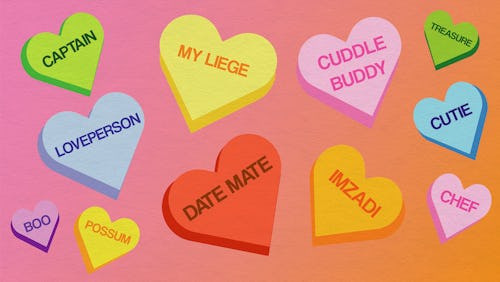We need more gender-fluid terms of endearment
What does “yes, queen” translate to when you’re gender nonbinary?

Recently, a friend of mine was recounting a seriously dramatic story about her ex and also her other ex. "Queen," she screamed, “it was bananas!” As a nonbinary person in a world that hasn’t quite caught up, I am accustomed to being called all kinds of feminizing things and frankly, “queen” is the least of my problems, so I didn’t say anything. Why correct well-intentioned people who are trying to vibe with me?
But I also can’t really control my face, and my friend stopped mid-story to apologize. But then she asked a question that I don’t know the answer to. "What do I call you? There's no equivalent to queen,” she said. Indeed.
We tried in vain to find a gender-free equivalent that has the same camaraderie as “queen.” I suggested “my liege,” but it just doesn’t have the same je ne sais quoi, so we mostly ended up lamenting the patriarchy and the fact that language is so limiting. It made me wonder if asking the world to speak to gender nonconforming people in totally new ways in order to express age old feelings of kinship isn’t a little high maintenance. On the one hand, terms of endearment are meant to be sweet and policing them doesn’t feel fun, but being misgendered doesn’t feel fun, either. What’s an easygoing enby to do?
Well, first of all, even though pet names are cute and fun, they actually express something important — intimacy. Research suggests that one of the main reasons that people use nicknames and the like is to demonstrate insider status with one another. The science behind why we use pet names has tended to focus on people in romantic relationships, but in one survey, 90% of Americans in happy relationships used pet names, as opposed to only 56% of people who were in unsatisfying relationships, Insider reported. I don’t think it’s much of a stretch to assume that we use language similarly in non-romantic intimate relationships — especially in queer kinship relations — which makes it seem even more important to find a way to embrace gender-free pet names.
The thing is that being recognized in your true gender identity does play a role in intimacy. And when we’re talking about using language to show affection and affinity in a broader social context, the way that we talk to each other doesn’t just demonstrate closeness between two people, it can change how we perceive whether or not a whole category of human — in this case, gender nonconforming people — is accepted by society. “Gender-neutral language is essential because it not only includes all individuals and groups while avoiding discriminating jargon, but it also encourages societal change and helps to achieve gender equality,” explains Elizabeth Lombardo, a Chicago-based psychologist.
Using gender-free terms of endearment, then, simultaneously shows intimacy between individuals and may also help us shape the way gender nonconforming people are treated on a larger scale. “Because language reflects and impacts attitudes, we must first modify the way we speak to treat all genders equally,” says Lombardo. So if we want to create a more equitable culture for all genders, using intimate language in a way that acknowledges someone’s complex identity may be a good place to start. If more people heard nonbinary people referred to as, say, gender-free fairy blossoms, maybe it would boost the way they think of nonbinary people.
Plus, experimenting with pet names is fun. I have a different moniker for my boo roughly every seventeen seconds. Sure, maybe none of them stick forever, but making him smile for a second feels like a win and no one wants to be typecast as a pretty pretty platypus anyways. Maybe if we could find a way to be more playful and fluid with language, we can also become more lighthearted and expansive in how we think about gender.